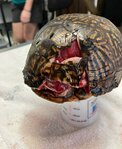Whether it's sea turtles, crabs, squirrels or pelicans, many animals live around the Gulf Coast. However, there are some that have become endangered or even extinct.
According to the U.S. Fish …
This item is available in full to subscribers.
Please log in to continue |

Whether it's sea turtles, crabs, squirrels or pelicans, many animals live around the Gulf Coast. However, there are some that have become endangered or even extinct.
According to the U.S. Fish and Wildlife Service, Alabama has the third-highest number of threatened or endangered species in the nation.
Animals that have gone extinct include: Bachman's warbler (songbird), Southern acornshell, stirrupshell, tubercled-blossom pearly mussel, turgid-blossom pearly mussel, upland combshell and the yellow-blossom pearly mussel.
According to Melissa Vinson, coastal programs coordinator for Orange Beach Wildlife Center (OBWC), gopher tortoises in the area are threatened.
"We definitely want to be mindful of them and their habitats and make sure we coexist," Vinson said. "We get them in our wildlife center because maybe they have gotten attacked by a dog or maybe stomped on by a horse, maybe they were in a barn or hit by cars."
Vinson advised individuals to be aware of their surroundings to ensure that the animals within our environment are safe and do not feel threatened.
"Some other things that people can do to help wildlife and to help their habitat is to turn your backyard or your front yard into some local habitat," she said. "Plant native plants that attract the local pollinators. Different things like that can all help."
Bay Keepers Communications Director Caine O'Rear said habitat protection is something this organization focuses on.
"We work a lot on habitat nourishment and protection," O'Rear said. "Our oyster gardening program helps reintroduce or restore the reefs."
According to O'Rear, since 1950 Mobile Bay has lost 80% of oyster reefs.
"The oysters are sort of the kidneys of the sea," he said. "They do a lot to improve water quality, which of course, helps with the fisheries and the natural habitat for aquatic life."
Other than the Oyster Gardening Program, Bay Keepers has installed stormwater runoffs to stop pollution from getting into the local waters.
"Mud is probably the biggest polluting factor we have," he said. "It makes it impossible for photosynthesis to occur when light can't penetrate the turbidity. It is hard for those plants to make food and seagrasses are a bedrock element of our ecosystem. It is what the fish rely on for food and a lot of aquatic species rely on it for food and protection."
Living on the Gulf Coast means living with the animals around. Being mindful and doing small things could change the life of the animals around us.